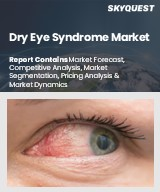
|
시장보고서
상품코드
1422070
인공눈물 시장 : 제품, 제형, 적응증, 배합, 유통 채널, 지역별, 기회 및 예측(2017-2031년)Artificial Tears Market Assessment, By Product, By Dosage Form, By Indication, By Formulation, By Distribution Channel, By Region, Opportunities and Forecast, 2017-2031F |
||||||
세계 인공눈물 시장 규모는 2023년 32억 7,000만 달러에서 예측 기간 동안 6.14%의 CAGR로 2031년에는 52억 6,000만 달러에 달할 것으로 예상됩니다.
세계 인공눈물 시장의 성장은 노화, 장시간 스크린 노출, 환경적 요인에 의한 안구건조증 발생률 증가 등 다양한 요인에 기인합니다. 또한, 안구 관리 기술의 발전과 안구건조증에 취약한 고령화 사회의 진행도 시장 성장을 크게 견인하고 있습니다. 또한, 라이프스타일의 변화와 눈 건강에 대한 인식의 변화도 시장 성장을 촉진하는 데 매우 중요한 역할을 하고 있습니다.
안구건조증 발병률 증가
안구건조증 증후군이 크게 증가하면서 세계 인공눈물 시장의 급속한 확장을 촉진하는 주요 요인으로 작용하고 있습니다. 안구건조증 증후군의 증가는 인구 고령화, 장시간 스크린 사용, 환경적 요인 등 다양한 영향으로 인해 발생합니다. 노화에 따른 생리적 변화로 인해 눈물 분비량이 변화하여 안구 건조증에 걸리기 쉽습니다.
또한, 컴퓨터나 스마트폰과 같은 기기의 장시간 화면 노출은 눈의 피로와 그에 따른 안구건조증에 큰 영향을 미칩니다. 오염과 건조한 기후와 같은 환경적 요인도 이러한 문제를 악화시켜 인공누액에 대한 수요를 증가시키고 있습니다. 안구건조증 유병률의 증가는 인공눈물 처방 및 치료 방법의 지속적인 발전과 혁신을 촉진하는 매우 중요한 요인입니다. 이러한 발전은 안구 증상 완화를 원하는 사람들의 증가하는 수요에 부응하고 있습니다.
기술의 발전
기술의 발전은 인공눈물 세계 시장을 촉진하는 촉매제 역할을 합니다. 안과 의료 기술의 지속적인 혁신은 안구건조증 문제를 관리할 수 있는 보다 효율적이고 전문적인 치료법을 지속적으로 개발하고 있습니다. 이러한 획기적인 혁신은 개선된 제형, 정확한 전달 시스템, 개선된 진단 장비를 제시함으로써 치료 접근 방식을 크게 변화시키고 있습니다. 첨단 기술을 통해 환자 개개인의 요구에 맞는 인공눈물 제제 개발이 용이해져 효과와 편의성이 향상되고 있습니다. 이러한 발전은 시장을 확대하고 인공눈물 제품의 수준을 높이며 안구건조증 완화를 원하는 사람들의 진화하는 요구를 충족시키는 데 도움이 되고 있습니다.
세계 인공눈물 시장을 조사했으며, 시장 정의와 개요, 시장 규모 추이와 예측, 각종 부문별·지역별 상세 분석, 산업 구조, 시장 성장에 영향을 미치는 요인 분석, 사례 연구, 경쟁 상황, 주요 기업 개요 등의 정보를 정리하여 전해드립니다.
목차
제1장 조사 방법
제2장 프로젝트 범위와 정의
제3장 주요 요약
제4장 세계의 인공눈물 시장 전망
- 시장 규모와 예측
- 제품별
- 히알루론산나트륨
- 폴리에틸렌 글리콜
- 프로필렌 글리콜
- 유성 에멀전
- 셀룰로오스
- 글리세린
- 제형별
- 솔루션
- 유제
- 연고
- 분사
- 겔
- 현탁액
- 적응증별
- 안구건조증
- 감염증
- 알레르기
- 콘택트렌즈 보습
- 자외선과 블루 라이트 차단
- 기타
- 배합별
- 방부제 사용
- 방부제 미사용
- 유통 채널별
- 병원 약국
- 소매 약국
- 안과 약국
- 온라인 약국
- 지역별
- 북미
- 유럽
- 남미
- 아시아태평양
- 중동 및 아프리카
- 기업별 시장 점유율
제5장 세계의 인공눈물 시장 전망 : 지역별
- 북미
- 유럽
- 남미
- 아시아 태평
- 중동 및 아프리카
제6장 시장 매핑
- 제품별
- 제형별
- 적응증별
- 배합별
- 유통 채널별
- 지역별
제7장 거시적 환경과 산업 구조
- 수급 분석
- 수출입 분석
- 밸류체인 분석
- PESTEL 분석
- Porter's Five Forces 분석
제8장 시장 역학
- 성장 추진요인
- 성장 억제요인(과제·장벽)
제9장 규제 프레임워크·혁신
- 임상시험
- 특허 상황
- 규제 당국 승인
- 혁신/최신 기술
제10장 주요 기업 상황
- 시장 리더 상위 5개사 경쟁 매트릭스
- 시장 리더 상위 5개사 시장 매출 분석
- M&A·합작투자(해당되는 경우)
- SWOT 분석(참여 5개사)
- 특허 분석(해당되는 경우)
제11장 가격 분석
제12장 사례 연구
제13장 주요 기업 전망
- Johnson & Johnson Services, Inc.
- Bausch & Lomb Incorporated
- AbbVie Inc.
- Alimera Sciences, Inc.
- Sun Pharmaceutical Industries Limited
- Akorn Operating Company LLC
- Alcon Laboratories Inc.
- OCuSOFT Inc.
- Santen Pharmaceutical Co., Ltd.
- Similasan AG
- Ursapharm Arzneimittel GmbH
- Allergan plc
제14장 전략적 제안
제15장 당사 소개와 면책사항
ksm 24.02.19Global artificial tears market size was valued at USD 3.27 billion in 2023, which is expected to reach USD 5.26 billion in 2031, with a CAGR of 6.14% for the forecast period between 2024 and 2031F. The growth of global artificial tears market stems from various elements such as rising incidence of dry eye syndrome influenced by age, prolonged screen exposure, and environmental factors. Moreover, advancements in eye care technology and a progressively aging population prone to dry eye problems significantly propel the expansion of global artificial tears market. Furthermore, changes in lifestyle and heightened awareness regarding eye health play pivotal roles in fostering market growth.
The growth of the global artificial tears market finds its foundation in many factors. Surging prevalence of dry eye syndrome is a pivotal driver behind the upward momentum of global artificial tears market. The increase is notably influenced by diverse elements, encompassing an aging population, prolonged exposure to screens, and environmental circumstances. Advancing age heightens susceptibility to dry eye issues due to alterations in tear production and composition. Similarly, extended screen usage, like computers and smartphones, contributes to eye strain and dryness. Moreover, factors such as pollution and arid climates compound these challenges, further amplifying the demand for artificial tear remedies.
Advancements in eye care technologies significantly propel the expansion of the global artificial tears market. Consistently evolving treatments and therapies present more efficient and tailored approaches to tackle dry eye conditions. Additionally, the ongoing global demographic shift towards an older population substantially contributes to the market growth. As individuals age, the probability of encountering dry eye symptoms surges, escalating the need for artificial tears. Furthermore, evolving lifestyles and heightened awareness regarding eye health play a pivotal role in nurturing the market's trajectory. With increased emphasis on preventive healthcare practices, people actively seek solutions for dry eye discomfort, contributing to sustained market expansion. The intricate interplay of factors collectively propels the upward trajectory of the global artificial tears market.
Rising Incidence of Dry Eye Syndrome
The significant increase in dry eye syndrome prevalence is a primary force driving the rapid expansion of the global artificial tears market. An increase in dry eye instances results from various influences, including an aging population, extended screen usage, and environmental factors. Age-related physiological changes render individuals more susceptible to dry eye issues due to shifts in tear production.
Simultaneously, prolonged screen exposure from devices like computers and smartphones contributes substantially to eye strain and subsequent dryness. Environmental elements such as pollution and dry climates also exacerbate these concerns, amplifying the demand for artificial tear solutions. The rising prevalence of dry eye syndrome is a pivotal catalyst, stimulating continuous advancements and innovations in artificial tear formulations and therapies. These advancements address the expanding needs of individuals seeking relief from widespread ocular conditions.
Technological Advancements
Technological progressiveness acts as a catalyst, propelling the global artificial tears market. Ongoing innovations in eye care technologies consistently produce more efficient and specialized remedies for managing dry eye issues. These breakthroughs transform treatment approaches by presenting enhanced formulations, accurate delivery systems, and improved diagnostic instruments. Advanced technologies facilitate the creation of tailored artificial tear formulations, enhancing effectiveness and comfort for individual patient requirements. The advancements help to widen the market and elevate the standards of artificial tear products, fulfilling the evolving needs of those seeking relief from dry eye symptoms.
For instance, in May 2023, Entod Pharmaceuticals, a research-based Ophthalmic, ENT & Dermatology Pharmaceutical Company, announced the launch of Cyclotears, an eye drop, in India and its various global markets. Based on self-emulsifying drug delivery system (SEDDS) technology, the eye drops are used for patients with inflammatory dry eye disease (DED). The company hails it as the first dry eye therapy in the world that incorporates SEDDS technology.
Government Initiatives
Around the globe, governments are actively launching diverse strategies to strengthen the global artificial tears market. These strategies involve financing research initiatives to progress eye health solutions and stimulate advancements in treatments for ocular conditions. Furthermore, regulatory bodies are adopting favorable policies to expedite the authorization of new artificial tear formulas, fostering market development. Partnerships between public health sectors and industry players drive awareness initiatives, educating people about eye health, and available remedies for ailments such as dry eyes. These combined efforts propel market growth and underscore the importance of ocular health in worldwide public healthcare priorities. For example, the Karnataka State Health Department and the National Programme for Control of Blindness collaborated to create Asha Kirana - Eye Care at Your Doorstep - a groundbreaking program in the Chickballapur area in September 2023. The districts of Kalaburagi, Haveri, and Chamarajanagar are now included in this scheme. The program is an essential first step in closing the accessibility gap for eye health.
Artificial Tears for Dry Eye Disease
The extensive use of artificial tears to address dry eye disease significantly propels the thriving global artificial tears market. As dry eye cases escalate globally, there's an increased quest for viable solutions. Artificial tears promptly soothe discomfort by moisturizing and lubricating the eyes, easing dryness. Furthermore, the ease of access and convenience of these over-the-counter remedies greatly contribute to their widespread acceptance. As people increasingly seek relief from dry eye symptoms, the artificial tears market expands, meeting the growing demands of a diverse population affected by the widespread eye condition.
For example, Bausch + Lomb, an American Canadian eye health products company, in September 2023, announced the commercial launch of Miebo, an ophthalmic solution containing perfluorohexyl octane that is intended to treat dry eye symptoms by addressing tear evaporation directly. Miebo is a prescription eye drop with just one ingredient that distributes easily and fast, minimizing tear evaporation at the ocular surface. It is free of water, preservatives, and steroids.
Growing Demand for Glycerin Tears
The global artificial tears market is experiencing a rise in the request for glycerin-infused variants. Heightened demand arises from the exceptional moisturizing qualities inherent in glycerin, which is particularly beneficial for managing dry eyes. Glycerin-based tears emulate the eye's natural tear film, ensuring prolonged hydration and proficiently relieving discomfort. The increasing preference for these artificial tears is driven by their ability to effectively sustain ocular moisture levels, presenting a comprehensive solution for dryness. As individuals actively pursue dependable remedies for dry eye symptoms, the distinct attributes of glycerin-based tears position them prominently, fueling their amplified adoption in the global artificial tears market.
For instance, in March 2023, Avenova Pharmaceuticals, Inc. and Eyeganics announced a collaboration to market OTC Organic Tears (0.2% organic glycerin) via Avenova's physician-dispensed channel and on Avenova.com. Organic Tears is a lubricating eye drop approved by the USDA as 100% organic and devoid of preservatives, it contains neither artificial chemicals nor additions. Compared to other preservative-free artificial tears found in single-use vials, Organic Tears are more affordable and convenient due to their breakthrough technology that dispenses more than 250 drops in each bottle of 10 ml quantity of product, available for USD 29.
Future Market Scenario
The prospects for the global artificial tears market are notably optimistic, driven by several key elements. Increasing prevalence of conditions like dry eye syndrome, linked to factors such as aging populations and heightened screen usage, continue to broaden the market's reach. Additionally, ongoing advancements in eye care technologies hold the promise of novel formulations and delivery methods, enhancing the effectiveness of artificial tear remedies. Moreover, increasing awareness regarding ocular health and the availability of easily accessible over-the-counter artificial tears propel market expansion.
Furthermore, the pursuit of improved formulations, including preservative-free variants and those tailored for specific dry eye variations, fosters market growth and diversification. The evolution caters to the changing requirements of a broader demographic seeking relief from dry eye discomfort, ensuring sustained growth and ongoing innovation in the artificial tears market.
Key Players Landscape and Outlook
The top firms in global artificial tears market are actively engaging in merger and acquisition tactics. These initiatives encompass larger corporations collaborating or buying smaller enterprises to diversify their product ranges, bolster research potential, and extend market presence. These strategic maneuvers facilitate entry to innovative technologies and various products, cultivating competitive edges. Moreover, mergers and acquisitions allow companies to fortify their standings, leverage synergies, and streamline operations, reinforcing their positions in the ever-evolving artificial tears sector.
For example, in July 2023, Bausch acquired Johnson & Johnson Vision's Blink product line of eye and contact lens drops + Lomb Corporation, a renowned worldwide eye health firm committed to enabling people to see better to live better. The company's ongoing efforts to improve consumer convenience for over-the-counter (OTC) eye care is exemplified by this strategic purchase. With the addition of Blink, the company's extensive portfolio of over-the-counter eye care brands has expanded, giving consumers and eye care professionals even more options.
Table of Contents
1. Research Methodology
2. Project Scope & Definitions
3. Executive Summary
4. Global Artificial Tears Market Outlook, 2017-2031F
- 4.1. Market Size & Forecast
- 4.1.1. Value
- 4.1.2. Volume
- 4.2. By Product
- 4.2.1. Sodium Hyaluronate Based Artificial Tears
- 4.2.2. Polyethylene Glycol-based Tears
- 4.2.3. Propylene Glycol-based Tears
- 4.2.4. Oil-based Emulsion Tears
- 4.2.5. Cellulose Tears
- 4.2.6. Glycerin Tears
- 4.3. By Dosage Form
- 4.3.1. Solution
- 4.3.2. Emulsion
- 4.3.3. Ointment
- 4.3.4. Spray
- 4.3.5. Gel
- 4.3.6. Suspensions
- 4.4. By Indication
- 4.4.1. Dry Eye Syndrome
- 4.4.2. Infections
- 4.4.3. Allergies
- 4.4.4. Contact Lens Moisture Retention
- 4.4.5. UV & Blue Light Protection
- 4.4.6. Others
- 4.5. By Formulation
- 4.5.1. Preservative Based
- 4.5.2. Non-Preservative Based
- 4.6. By Distribution Channel
- 4.6.1. Hospital Pharmacies
- 4.6.2. Retail Pharmacies
- 4.6.3. Ophthalmic Pharmacies
- 4.6.4. Online Pharmacies
- 4.7. By Region
- 4.7.1. North America
- 4.7.2. Europe
- 4.7.3. South America
- 4.7.4. Asia-Pacific
- 4.7.5. Middle East and Africa
- 4.8. By Company Market Share (%), 2023
5. Global Artificial Tears Market Outlook, By Region, 2017-2031F
- 5.1. North America*
- 5.1.1. Market Size & Forecast
- 5.1.1.1. Value
- 5.1.1.2. Volume
- 5.1.2. By Product
- 5.1.2.1. Sodium Hyaluronate Based Artificial Tears
- 5.1.2.2. Polyethylene Glycol-based Tears
- 5.1.2.3. Propylene Glycol-based Tears
- 5.1.2.4. Oil-based Emulsion Tears
- 5.1.2.5. Cellulose Tears
- 5.1.2.6. Glycerin Tears
- 5.1.3. By Dosage Form
- 5.1.3.1. Solution
- 5.1.3.2. Emulsion
- 5.1.3.3. Ointment
- 5.1.3.4. Spray
- 5.1.3.5. Gel
- 5.1.3.6. Suspensions
- 5.1.4. By Indication
- 5.1.4.1. Dry Eye Syndrome
- 5.1.4.2. Infections
- 5.1.4.3. Allergies
- 5.1.4.4. Contact Lens Moisture Retention
- 5.1.4.5. UV & Blue Light Protection
- 5.1.4.6. Others
- 5.1.5. By Formulation
- 5.1.5.1. Preservative Based
- 5.1.5.2. Non-Preservative Based
- 5.1.6. By Distribution Channel
- 5.1.6.1. Hospital Pharmacies
- 5.1.6.2. Retail Pharmacies
- 5.1.6.3. Ophthalmic Pharmacies
- 5.1.6.4. Online Pharmacies
- 5.1.7. United States*
- 5.1.7.1. Market Size & Forecast
- 5.1.7.1.1. Value
- 5.1.7.1.2. Volume
- 5.1.7.2. By Product
- 5.1.7.2.1. Sodium Hyaluronate Based Artificial Tears
- 5.1.7.2.2. Polyethylene Glycol-based Tears
- 5.1.7.2.3. Propylene Glycol-based Tears
- 5.1.7.2.4. Oil-based Emulsion Tears
- 5.1.7.2.5. Cellulose Tears
- 5.1.7.2.6. Glycerin Tears
- 5.1.7.3. By Dosage Form
- 5.1.7.3.1. Solution
- 5.1.7.3.2. Emulsion
- 5.1.7.3.3. Ointment
- 5.1.7.3.4. Spray
- 5.1.7.3.5. Gel
- 5.1.7.3.6. Suspensions
- 5.1.7.4. By Indication
- 5.1.7.4.1. Dry Eye Syndrome
- 5.1.7.4.2. Infections
- 5.1.7.4.3. Allergies
- 5.1.7.4.4. Contact Lens Moisture Retention
- 5.1.7.4.5. UV & Blue Light Protection
- 5.1.7.4.6. Others
- 5.1.7.5. By Formulation
- 5.1.7.5.1. Preservative Based
- 5.1.7.5.2. Non-Preservative Based
- 5.1.7.6. By Distribution Channel
- 5.1.7.6.1. Hospital Pharmacies
- 5.1.7.6.2. Retail Pharmacies
- 5.1.7.6.3. Ophthalmic Pharmacies
- 5.1.7.6.4. Online Pharmacies
- 5.1.8. Canada
- 5.1.9. Mexico
- 5.1.1. Market Size & Forecast
All segments will be provided for all regions and countries covered:
- 5.2. Europe
- 5.2.1 Germany
- 5.2.2 France
- 5.2.3 Italy
- 5.2.4 United Kingdom
- 5.2.5 Russia
- 5.2.6 Netherlands
- 5.2.7 Spain
- 5.2.8 Turkey
- 5.2.9 Poland
- 5.3. South America
- 5.3.1. Brazil
- 5.3.2. Argentina
- 5.4. Asia-Pacific
- 5.4.1. India
- 5.4.2. China
- 5.4.3. Japan
- 5.4.4. Australia
- 5.4.5. Vietnam
- 5.4.6. South Korea
- 5.4.7. Indonesia
- 5.4.8. Philippines
- 5.5. Middle East & Africa
- 5.5.1. Saudi Arabia
- 5.5.2. UAE
- 5.5.3. South Africa
6. Market Mapping, 2023
- 6.1. By Product
- 6.2. By Dosage Form
- 6.3. By Indication
- 6.4. By Formulation
- 6.5. By Distribution Channel
- 6.6. By Region
7. Macro Environment and Industry Structure
- 7.1. Supply Demand Analysis
- 7.2. Import Export Analysis
- 7.3. Value Chain Analysis
- 7.4. PESTEL Analysis
- 7.4.1. Political Factors
- 7.4.2. Economic System
- 7.4.3. Social Implications
- 7.4.4. Technological Advancements
- 7.4.5. Environmental Impacts
- 7.4.6. Legal Compliances and Regulatory Policies (Statutory Bodies Included)
- 7.5. Porter's Five Forces Analysis
- 7.5.1. Supplier Power
- 7.5.2. Buyer Power
- 7.5.3. Substitution Threat
- 7.5.4. Threat from New Entrant
- 7.5.5. Competitive Rivalry
8. Market Dynamics
- 8.1. Growth Drivers
- 8.2. Growth Inhibitors (Challenges and Restraints)
9. Regulatory Framework and Innovation
- 9.1. Clinical Trials
- 9.2. Patent Landscape
- 9.3. Regulatory Approvals
- 9.4. Innovations/Emerging Technologies
10. Key Players Landscape
- 10.1. Competition Matrix of Top Five Market Leaders
- 10.2. Market Revenue Analysis of Top Five Market Leaders (in %, 2023)
- 10.3. Mergers and Acquisitions/Joint Ventures (If Applicable)
- 10.4. SWOT Analysis (For Five Market Players)
- 10.5. Patent Analysis (If Applicable)
11. Pricing Analysis
12. Case Studies
13. Key Players Outlook
- 13.1. Johnson & Johnson Services, Inc.
- 13.1.1. Company Details
- 13.1.2. Key Management Personnel
- 13.1.3. Products & Services
- 13.1.4. Financials (As reported)
- 13.1.5. Key Market Focus & Geographical Presence
- 13.1.6. Recent Developments
- 13.2. Bausch & Lomb Incorporated
- 13.3. AbbVie Inc.
- 13.4. Alimera Sciences, Inc.
- 13.5. Sun Pharmaceutical Industries Limited
- 13.6. Akorn Operating Company LLC
- 13.7. Alcon Laboratories Inc.
- 13.8. OCuSOFT Inc.
- 13.9. Santen Pharmaceutical Co., Ltd.
- 13.10. Similasan AG
- 13.11. Ursapharm Arzneimittel GmbH
- 13.12. Allergan plc
Companies mentioned above DO NOT hold any order as per market share and can be changed as per information available during research work.



















